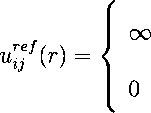where,
4⅞V) = 4¾


(6.25)
rc is the potential cut-off, σij — (σi + σj∙)∕2 and eʊ = yJtitj- If rc = 21∕6σ⅛ then
the potential is purely repulsive. To include attraction the range of LJ interaction
(or potential cut-off) is extended to rc = 2.5σij. In modified iSAFT, the long range
attractions are added as a perturbation to the hard repulsion (reference fluid). For
the LJ potential, the attractions are treated in the spirit OfWeeks-Chandler-Anderson
(WCA) perturbation theory [120, 121].
uij(r) = uτ^{r) + uɑf(r),
(6.26)
where

if r < ay-
otherwise
(6.27)
and
<i(r) = <
Ui-j(rmin) - r⅛7(rc) σij <r <r.
(6.28)
Uijj(r) - u⅛,(rc)
Tmin — T
rmm = 21∕% is the position of the (LJ) potential minima.
We first studied the structure of hard (athermal) chains tethered to a flat hard
surface. This corresponds to the case where chains are present in an implicit good
solvent. The chains are assumed to be uniformly distributed on the surface. Hence
156
More intriguing information
1. The name is absent2. The name is absent
3. Analyzing the Agricultural Trade Impacts of the Canada-Chile Free Trade Agreement
4. The name is absent
5. Insurance within the firm
6. Climate change, mitigation and adaptation: the case of the Murray–Darling Basin in Australia
7. CURRENT CHALLENGES FOR AGRICULTURAL POLICY
8. Unilateral Actions the Case of International Environmental Problems
9. The name is absent
10. Higher education funding reforms in England: the distributional effects and the shifting balance of costs